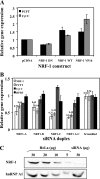The obligatory intestinal folate transporter PCFT (SLC46A1) is regulated by nuclear respiratory factor 1
- PMID: 20724482
- PMCID: PMC2962458
- DOI: 10.1074/jbc.M110.135640
The obligatory intestinal folate transporter PCFT (SLC46A1) is regulated by nuclear respiratory factor 1
Abstract
Folates are essential vitamins that play a key role as one-carbon donors in a spectrum of biosynthetic pathways including RNA and DNA synthesis. The proton-coupled folate transporter (PCFT/SLC46A1) mediates obligatory intestinal folate absorption. Loss-of-function mutations in PCFT result in hereditary folate malabsorption, an autosomal recessive disorder characterized by very low folate levels in the blood and cerebrospinal fluid. Hereditary folate malabsorption manifests within the first months after birth with anemia, immune deficiency, and neurological deficits. Here we studied the role of inducible trans-activators of PCFT gene expression. Bioinformatics identified three putative nuclear respiratory factor 1 (NRF-1) binding sites in the minimal promoter. The following evidence establish that PCFT is an NRF-1-responsive gene; electrophoretic mobility shift assay showed NRF-1 binding to native but not mutant NRF-1 sites, whereas antibody-mediated supershift analysis and chromatin immunoprecipitation revealed NRF-1 binding to its consensus sites within the PCFT promoter. Moreover, mutational inactivation of individual or all NRF-1 binding sites resulted in 40-60% decrease in luciferase reporter activity. Consistently, overexpression of NRF-1 or a constitutively active NRF-1 VP-16 construct resulted in increased reporter activity and PCFT mRNA levels. Conversely, introduction of a dominant-negative NRF-1 construct markedly repressed reporter activity and PCFT mRNA levels; likewise, introduction of NRF-1 siRNA duplexes to cells resulted in decreased PCFT transcript levels. Moreover, NRF-1 silencing down-regulated genes encoding for key folate transporters and enzymes in folate metabolism. These novel findings identify NRF-1 as a major inducible transcriptional regulator of PCFT gene expression. The implications of this linkage between folate transport and metabolism with mitochondria biogenesis and respiration are discussed.
Figures






Similar articles
-
Role of the glutamate 185 residue in proton translocation mediated by the proton-coupled folate transporter SLC46A1.Am J Physiol Cell Physiol. 2009 Jul;297(1):C66-74. doi: 10.1152/ajpcell.00096.2009. Epub 2009 Apr 29. Am J Physiol Cell Physiol. 2009. PMID: 19403800 Free PMC article.
-
Nuclear respiratory factor 1 (NRF-1) upregulates the expression and function of reduced folate carrier (RFC) at the blood-brain barrier.FASEB J. 2020 Aug;34(8):10516-10530. doi: 10.1096/fj.202000239RR. Epub 2020 Jun 16. FASEB J. 2020. PMID: 32543769
-
The functional roles of the His247 and His281 residues in folate and proton translocation mediated by the human proton-coupled folate transporter SLC46A1.J Biol Chem. 2009 Jun 26;284(26):17846-57. doi: 10.1074/jbc.M109.008060. Epub 2009 Apr 23. J Biol Chem. 2009. PMID: 19389703 Free PMC article.
-
The proton-coupled folate transporter (PCFT-SLC46A1) and the syndrome of systemic and cerebral folate deficiency of infancy: Hereditary folate malabsorption.Mol Aspects Med. 2017 Feb;53:57-72. doi: 10.1016/j.mam.2016.09.002. Epub 2016 Sep 21. Mol Aspects Med. 2017. PMID: 27664775 Free PMC article. Review.
-
Biology of the major facilitative folate transporters SLC19A1 and SLC46A1.Curr Top Membr. 2014;73:175-204. doi: 10.1016/B978-0-12-800223-0.00004-9. Curr Top Membr. 2014. PMID: 24745983 Free PMC article. Review.
Cited by
-
The human proton-coupled folate transporter: Biology and therapeutic applications to cancer.Cancer Biol Ther. 2012 Dec;13(14):1355-73. doi: 10.4161/cbt.22020. Epub 2012 Sep 6. Cancer Biol Ther. 2012. PMID: 22954694 Free PMC article. Review.
-
Nuclear respiratory factor 1 and endurance exercise promote human telomere transcription.Sci Adv. 2016 Jul 27;2(7):e1600031. doi: 10.1126/sciadv.1600031. eCollection 2016 Jul. Sci Adv. 2016. PMID: 27819056 Free PMC article.
-
Nuclear Respiratory Factor 1 (NRF-1) Controls the Activity Dependent Transcription of the GABA-A Receptor Beta 1 Subunit Gene in Neurons.Front Mol Neurosci. 2018 Aug 21;11:285. doi: 10.3389/fnmol.2018.00285. eCollection 2018. Front Mol Neurosci. 2018. PMID: 30186109 Free PMC article.
-
The role of mitochondrial biogenesis, mitochondrial dynamics and mitophagy in gastrointestinal tumors.Cancer Cell Int. 2025 Feb 15;25(1):46. doi: 10.1186/s12935-025-03685-2. Cancer Cell Int. 2025. PMID: 39955547 Free PMC article. Review.
-
Mechanistic target of rapamycin (mTOR) regulates trophoblast folate uptake by modulating the cell surface expression of FR-α and the RFC.Sci Rep. 2016 Aug 26;6:31705. doi: 10.1038/srep31705. Sci Rep. 2016. PMID: 27562465 Free PMC article.
References
-
- Appling D. R. (1991) FASEB J. 5, 2645–2651 - PubMed
-
- Stockstad E. L. R. (1990) Folic Acid Metabolism in Health and Disease, pp. 1–21, Wiley-Liss, New York
-
- Assaraf Y. G. (2007) Cancer Metastasis Rev. 26, 153–181 - PubMed
-
- Dixon K. H., Lanpher B. C., Chiu J., Kelley K., Cowan K. H. (1994) J. Biol. Chem. 269, 17–20 - PubMed
-
- Matherly L. H., Hou Z., Deng Y. (2007) Cancer Metastasis Rev. 26, 111–128 - PubMed
MeSH terms
Substances
LinkOut - more resources
Full Text Sources

